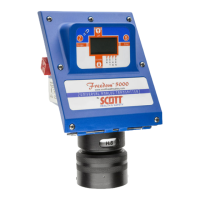18
087-0020 REV E
Environmental Influences to the Scott Safety Sensor
Although the Freedom™ 5000 transmitter is designed to operate at
temperatures from -40° to 140°F (-40° to 60° C), the operating
temperature is dictated by which gas sensor has been installed. The
GasPlus Sensor Operating Parameters Addenda (see back of
manual) show the operating temperature ranges for each sensor type.
Extreme hot temperatures and exposure to dirty atmospheres containing
particulate matter or oily vapors can affect sensor response and
decrease sensor life. Extreme cold temperatures, if below the rated
value of the sensor, have the potential of freezing the sensor electrolyte
and thus damaging the sensor permanently.
Humidity (%RH) has the potential to affect the performance of
electrochemical sensors. Gas sensors are designed to provide stable
output over a range of humidity conditions. Intermittent exposure to
relative humidity conditions from 10% to 99% non-condensing RH will
not affect operation of most sensors. Scott Safety typically provides a
low humidity version (electrolyte balanced for 50% R.H. equilibrium) and
a high humidity version (electrolyte balanced for 75% R.H. equilibrium)
sensor.
Most indoor HVAC cont
rolled environments will use a low humidity
sensor while most outdoor applications will use a high humidity version.
In those applications where there is doubt as to which sensor should be
used it is advisable to use the high humidity version. Contact your Scott
Safety representative for assistance in selecting the proper type for your
application.
Extremely dry air
has the potential to adversely affect the operation of
electrochemical sensors. At a R.H. continuously below 25%, sensors can
exhibit an early loss of sensitivity after a few days to a week of operation.
This is caused by a slow loss of water from the internal sensor
electrolyte. Suspending the sensor over a jar of water for 24 hours will
usually restore sensitivity
.
Extremely humid or wet conditions can affect these sensors which
rely on an unobstructed gas diffusion path into the sensor. If the gas
stream or ambient air allows humidity to condense on the sensor, the
water on the membrane will cause loss of sensitivity, or slow response,
or both. Once the sensor has had a chance to dry out, normal operation
should be restored. If the source of moisture is a result of water spray or
rain, a rain shield may be installed on the sensor module to protect the
sensing membrane. Keep in mind that some gases may chemically react
with water vapor and be converted to other species (e.g., ammonia
hydrolyzes to form ammonium hydroxide when exposed to water vapor).
In addition, other gases such as hydrogen fluoride are very reactive and
may be absorbed on the inner surfaces of flow tubing before reaching
the sensor during calibration. Such questions should be referred to
chemists or industrial hygienists.
Freedom 5000 Universal Analog Toxic Gas Detector
Instruction Manual

